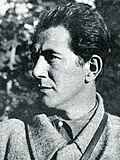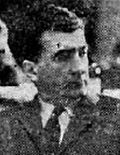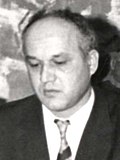| No. | Portrait | Name
(Birth–Death) | Term of office | Political party | Representing |
|---|
| Took office | Left office | Time in office |
|---|
| 1 |  | Ivan Ribar
(1881–1968) [a] | 26 October 1942 [b] | 5 March 1945 | 2 years, 130 days | KPJ | N/A |
|---|
| 2 |  | Lazar Sokolov [ sr ]
(1914–1984) | 5 March 1945 | 29 November 1945 | 269 days | KPJ |
|---|
| 3 |  | Vladimir Simić [ sr ]
(1894–1974) | 29 November 1945 | 25 December 1953 | 8 years, 26 days | KPJ
SKJ |
|---|
| 4 |  | Milovan Đilas
(1911–1995) | 25 December 1953 | 16 January 1954 | 22 days | SKJ |
|---|
| 5 |  | Moša Pijade
(1890–1957) | 29 January 1954 | 14 March 1957† | 3 years, 44 days | SKJ |
|---|
| 6 |  | Petar Stambolić
(1912–2007) | 26 March 1957 | 29 June 1963 | 6 years, 95 days | SKJ |
|---|
| 7 |  | Edvard Kardelj
(1910–1979) | 29 June 1963 | 16 May 1967 | 3 years, 321 days | SKJ |
|---|
| 8 |  | Milentije Popović
(1913–1971) | 16 May 1967 | 8 May 1971† | 3 years, 357 days | SKJ |
|---|
| 9 |  | Mijalko Todorović [ sr ]
(1913–1999) | 29 May 1971 | 15 May 1974 | 2 years, 351 days | SKJ |
|---|
| 10 |  | Kiro Gligorov
(1917–2012) | 15 May 1974 | 15 May 1978 | 4 years | SKJ |
|---|
| 11 |  | Dragoslav Marković
(1920–2005) | 15 May 1978 | 14 May 1982 | 3 years, 364 days | SKJ |
|---|
| 12 |  | Raif Dizdarević
(born 1926) | 15 May 1982 | 13 May 1983 | 363 days | SKJ | Bosnia and Herzegovina |
|---|
| 13 |  | Vojo Srzentić [ sr ]
(born 1934) | 13 May 1983 | 15 May 1984 | 1 year, 2 days | SKJ | Montenegro |
|---|
| 14 |  | Dušan Alimpić [ de ]
(1921–2002) | 15 May 1984 | 15 May 1985 | 1 year | SKJ | SAP Vojvodina |
|---|
| 15 |  | Ilaz Kurteshi [ sr ]
(1927–2016) | 15 May 1985 | 15 May 1986 | 1 year | SKJ | SAP Kosovo |
|---|
| 16 |  | Ivo Vrandečić
(born 1927) | 15 May 1986 | 15 July 1987 | 1 year, 61 days | SKJ | Croatia |
|---|
| 17 |  | Marjan Rožič [ sl ]
(1932–2017) | 15 July 1987 | 15 May 1988 | 305 days | SKJ | Slovenia |
|---|
| 18 |  | Dušan Popovski [ bg ]
(1930–1998) | 15 May 1988 | 15 May 1989 | 1 year | SKJ | Macedonia |
|---|
| 19 |  | Slobodan Gligorijević [ sr ]
(1920–1999) | 15 May 1989 | 11 June 1992 | 3 years, 57 days | SKJ | Serbia |
|---|

















